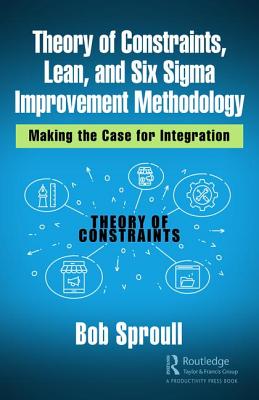Theory of Constraints, Lean, and Six SIGMA Improvement Methodology: Making the Case for Integration

Theory of Constraints, Lean, and Six SIGMA Improvement Methodology: Making the Case for Integration
Many leaders and managers have led improvement initiatives in a variety of different industry sectors. Most believe that when they begin these efforts, they already have the tools they need in their improvement "backpack." Using these tools, they make substantial improvements to processes in a wide array of industry segments. As time passes, however, most realize that there is a missing link in their arsenal of tools for improvement. The author of this book faced this same predicament and he discovered what the missing link was in his improvement tool kit: Theory of Constraints (TOC). Once he learned the details of TOC, his ability to make major improvements jettisoned upward to levels he had not seen before. TOC is the common denominator in all the case studies presented in this book.
This book opens with a chapter on what Theory of Constraints is and why it works so well in improvement efforts. The second and third chapters cover the important points related to Lean Manufacturing and Six Sigma as well as key points related to variability. Chapter 4 demonstrates how to effectively combine these three components to achieve maximum improvement and the corresponding enhancement to your company's profitability. The remainder of this book is composed of true case studies from different industry segments, using this integrated improvement methodology.
Essentially, this book lays the foundation for what most practitioners are just beginning to understand-this integrated improvement methodology is superior to the three components used in isolation from each other. This book presents a step-by-step method of how to combine the Theory of Constraints, Lean, and Six Sigma, and then demonstrates its effectiveness in a very diverse array of industries.
PRP: 422.30 Lei
Acesta este Prețul Recomandat de Producător. Prețul de vânzare al produsului este afișat mai jos.
380.07Lei
380.07Lei
422.30 LeiLivrare in 2-4 saptamani
Descrierea produsului
Many leaders and managers have led improvement initiatives in a variety of different industry sectors. Most believe that when they begin these efforts, they already have the tools they need in their improvement "backpack." Using these tools, they make substantial improvements to processes in a wide array of industry segments. As time passes, however, most realize that there is a missing link in their arsenal of tools for improvement. The author of this book faced this same predicament and he discovered what the missing link was in his improvement tool kit: Theory of Constraints (TOC). Once he learned the details of TOC, his ability to make major improvements jettisoned upward to levels he had not seen before. TOC is the common denominator in all the case studies presented in this book.
This book opens with a chapter on what Theory of Constraints is and why it works so well in improvement efforts. The second and third chapters cover the important points related to Lean Manufacturing and Six Sigma as well as key points related to variability. Chapter 4 demonstrates how to effectively combine these three components to achieve maximum improvement and the corresponding enhancement to your company's profitability. The remainder of this book is composed of true case studies from different industry segments, using this integrated improvement methodology.
Essentially, this book lays the foundation for what most practitioners are just beginning to understand-this integrated improvement methodology is superior to the three components used in isolation from each other. This book presents a step-by-step method of how to combine the Theory of Constraints, Lean, and Six Sigma, and then demonstrates its effectiveness in a very diverse array of industries.
Detaliile produsului









